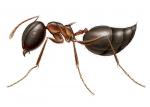Pest Identification
You're visiting our pest identification library with information about the biology and control of common household pests.
Acrobat Ant
| Appearance |
|---|
 Distinctive heart-shaped abdomen when viewed from above. 1/8- to 1/4-inch; black, dark brown, or red and black. Distinctive heart-shaped abdomen when viewed from above. 1/8- to 1/4-inch; black, dark brown, or red and black. |
| Habitat |
| Like carpenter ants, acrobat ants prefer to nest in moist or rotted wood. Colonies are most often found in tree holes, dead limbs and rotting areas in fences, decks and railings. Indoors, nests may be located where water damage has occurred, in decayed or damp wood or inside insulation wall panels and wall voids. When disturbed, acrobat worker ants run with their abdomens held high over their heads. |
| Diet |
|
Acrobat ants feed on a wide variety of foods, but the workers are partial to the sweet "honeydew" produced by aphids, scales and mealybugs. Most indoor acrobat ant problems are the result of workers looking for food.
|
| Control |
| Finding and treating wood where their colonies are located is the key to successful acrobat ant control. In cases where the nest is located far above the ground in a tree inaccessible to direct treatment, limiting the trails that lead to your interior is critical. Seal cracks and crevices in your foundation and walls, repair water leaks, let moist wood dry out, and improve attic and crawl space ventilation. |






